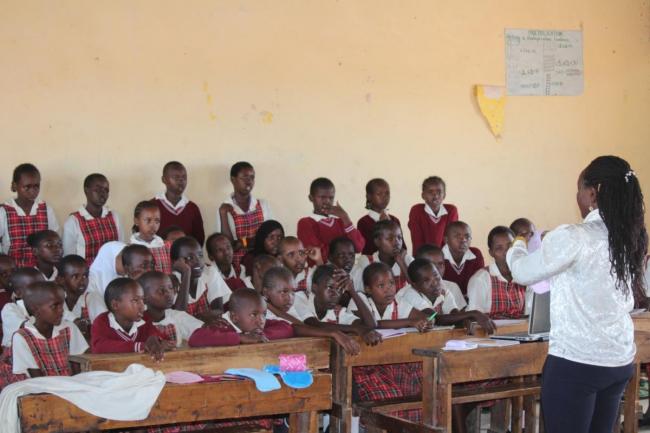The deep divide between governmental health policies on menstrual hygiene and the reality on the ground during the pandemic.
Published on: 08/02/2021

An MHM session with pubescent girls. Stakeholders have warned of a sharp increase in number of teen mothers post-COVID. Painting a grim picture of the disconnect between menstrual health and sexual and reproductive health information and rights.
It can be largely argued that concerted efforts towards battling the unseen global foe have been rewarding. Vaccines at record times are a milestone in taming a pandemic that has led to many lives being lost or irrevocably altered. With a virus death toll of over 2.1 million according to Johns Hopkins University and Medicine, Coronavirus Resource Center, COVID-19 is proving to be our collective reality bringing the global community together in unprecedented ways through shared tragedy and trauma. While governments continue to focus on measures to respond effectively to emerging health gaps, one of the visible effects of the pandemic are deeply divided nations over issues of public health policy.
Nonetheless, menstruation gained traction among decision makers involved in menstrual policy-formulation, innovation and engagement in 2020, demonstrating unequivocal efforts that resound ‘periods do not stop for pandemics’. The year 2020 was monumental in the menstrual health and hygiene space globally with the government of Kenya through the Ministry of Health launching the Menstrual Hygiene Management (MHM) Policy and Strategy amid COVID-19. Policy dissemination at sub-national government level has already started and the multi-sectoral approach in executing MHM activities has been boosted through coordinated response strengthened by the policy. Notably, in November Members of the Scottish Parliament unanimously approved the Period Products Free Provision Bill, making it a legal duty for local authorities to ensure free menstrual materials to anyone in need.
In 2007, Kenya reportedly scrapped tax on sanitary products to make them affordable to many girls and women who could not afford them. Close to a decade later, a study by Menstrual Hygiene Day in 2016 revealed that 65 percent of Kenyan girls and women cannot afford a sanitary pad. The government said it would provide all school-going girls with free sanitary pads after an amendment to the Education Act was signed into law in 2017. Even before the pandemic, a statement released in September 2019 showed that the government was experiencing bottlenecks distributing sanitary pads to four million girls, forcing some to drop out of school or even get married - potentially increasing cases of Sexually Transmitted Infections (STIs) including HIV. The government through the Public Service and Gender Affairs ministry said that sanitary pads worth Kshs 460 Million (approximately USD 4.2 Million) were issued to 3.7 million girls in public primary, secondary and special schools in the 2017-18 financial year admitting that “there were challenges because the money was not adequate”. Globally, organisations such as Sanitation and Water for All (SWA) are at the forefront of rallying finance ministers and other heads of governments to invest and make financial commitments within a sector highly underfunded and marred with corruption through Mutual Accountability Mechanisms.
Undoubtedly, Kenya's health sector, especially sexual and reproductive health and rights (SRHR), has been hit hard by the absence of learners in schools, medics on strike and a global pandemic that has worsened an already fragile situation. Education officials and stakeholders have warned that only 75 percent of registered pupils and students have reported back to school since opening on January 4, 2021 after a 10-month closure due to COVID. Where are the rest of the learners? How many are teenage mothers and just how much is being done to relieve their plight?
The sector, has not only experienced a surge in teenage pregnancy numbers consequently registering a drastic rise of teenage mothers countrywide, but also the potential risk of rolling back gains made over the years curbing harmful cultural practices like child marriage and Female Genital Mutilation (FGM).
COVID has exposed gaps that will require sector players and actors to review pragmatic and timely strategies especially now that there is demand for psychosocial support and counselling for teen mothers as well as a road map for going back to school without the fear of being stigmatised or looked down upon. “We hope to have quarterly review meetings starting 2021, this way; we’ll address gaps by responding to complex and diverse realities on the ground as a result of COVID-19”, said Neville Okwaro, a senior MHM trainer. “Of importance is the recognition that it is imperative to link critical aspects of health education in SRHR and MHM as they are known to be enablers and a force multiplier for girls’ and women’s cultural, social and economic growth and gender equality”, he concludes. Consequently, there is an urgent need to unpack the role of men and boys in addressing the teenage pregnancy conundrum as well as engage teenage girls as stakeholders in developing interventions tailored towards their needs and concerns, both in and out of school.
At IRC we have strong opinions and we value honest and frank discussion, so you won't be surprised to hear that not all the opinions on this site represent our official policy.